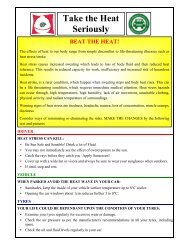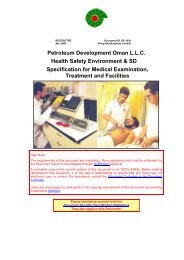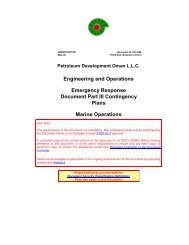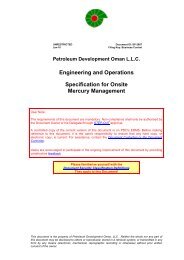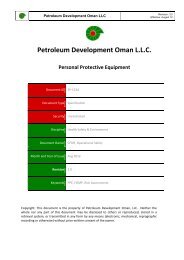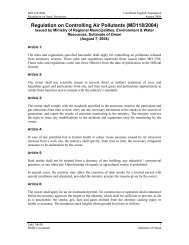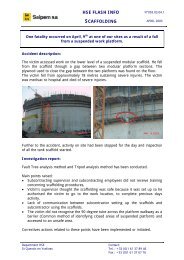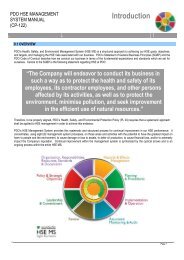CP-122 HSE Code of Practice - PDO
CP-122 HSE Code of Practice - PDO
CP-122 HSE Code of Practice - PDO
Create successful ePaper yourself
Turn your PDF publications into a flip-book with our unique Google optimized e-Paper software.
HEALTH, SAFETY AND ENVIRONMENT<br />
CODE OF PRACTICE (<strong>CP</strong>-<strong>122</strong>)<br />
<strong>PDO</strong> <strong>HSE</strong> Management System Manual<br />
In <strong>PDO</strong> <strong>HSE</strong>-MS Process 6, Implementation and Operation, general requirements for implementation <strong>of</strong> the change is presented.<br />
5.3.6 Technical Integrity<br />
Technical Integrity and management <strong>of</strong> <strong>HSE</strong> risks are closely linked. Maintaining Technical Integrity is a key element <strong>of</strong> Process<br />
Safety Management, the overall <strong>PDO</strong> <strong>HSE</strong>-MS, and is a major control mechanism to prevent and mitigate loss <strong>of</strong> containment<br />
and high risk process hazards (i.e., those with Severity 5 in the <strong>PDO</strong> RAM).<br />
<strong>PDO</strong> has chosen to align and measure its process safety management system and activities, including technical integrity, with<br />
The Center for Chemical Process Safety (C<strong>CP</strong>S) and their 20 Elements for Process Safety. These elements include, 1) Process<br />
Safety Culture; 2) Compliance with Standards; 3) Process Safety Competency; 4) Workforce Involvement; 5) Stakeholder<br />
Outreach; 6) Process Knowledge Management; 7) Hazards Identification and Risk Analysis (Renamed by <strong>PDO</strong> as Hazards and<br />
Effects Management Process - HEMP); 8) Operating Procedures (Renamed by <strong>PDO</strong> as Plant Operating Procedures); 9) Safe<br />
Work <strong>Practice</strong>s (Renamed by <strong>PDO</strong> as Permit to Work); 10) Asset Integrity and Reliability (Renamed by <strong>PDO</strong> as Technical<br />
Integrity); 11) Contractor Management; 12) Training and Performance Assurance; 13) Management <strong>of</strong> Change; 14) Operational<br />
Readiness; 15) Conduct <strong>of</strong> Operations; 16) Emergency Management; 17) Incident Investigations; 18) Measurement and Metrics;<br />
19) Auditing; 20) Management Review and Continuous Improvement.<br />
These Elements are embedded in the overall <strong>PDO</strong> <strong>HSE</strong>-MS and address Process Safety as and where relevant to <strong>PDO</strong><br />
operations, assets, and activities. <strong>PDO</strong> has developed various types <strong>of</strong> documentation (<strong>Code</strong>s <strong>of</strong> <strong>Practice</strong>, Procedures,<br />
Specifications, Guidelines, etc.) to address Technical Integrity, and these are listed in the References section <strong>of</strong> this process<br />
chapter and others as relevant.<br />
The <strong>PDO</strong> Technical Integrity system addresses areas such as design integrity, start-up, operating integrity, structural integrity,<br />
process containment, ignition control, and systems for protection, detection, shutdown, emergency response, and life saving.<br />
This system ensures that <strong>HSE</strong> critical facilities and equipment which are designed, constructed, procured, supplied,<br />
commissioned, operated, maintained, and/or inspected by <strong>PDO</strong> are suitable for their required purpose and comply with defined<br />
criteria. Only designated personnel can permit deviation(s) from approved technical integrity design practices and standards,<br />
and after a rigorous review and approval process, using the Management <strong>of</strong> Change process and relevant procedure(s). This is<br />
shown in the barrier diagram below.<br />
July 2011 Page 45







